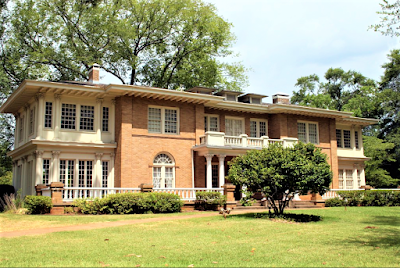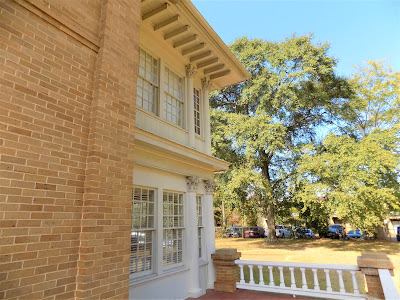 |
| photo: CJ McLaughlin 2021 |
Nacogoches

Sunday, October 31, 2021
The Mayer & Schmidt Building (1888-9)
The Galveston based merchants that had a wooden structure at this location pulled out of Nacogdoches inn 1888. This left John Schmidt an opening to purchase the property. He leveled the wooden structure and had Rulfs design a brick one to take its place. The original structure stands in the same place owned by the Mast Family. The façade has changed many times over the years. I remember taking a Gymnastics class on the top floor when this building served as The Nacogdoches Recreation Center. It has been a Law firm among many other uses.
 |
| 305 East Main by: CJ McLaughlin 2021 |
The John H. Cox Building (1888)
The Mayer & Schmidt building (1885)
Saturday, October 30, 2021
Diedrich Rulfs
Diedrich Anton Wilhelm Rulfs was born in Oldenburg, Germany, on March 6, 1848. A family friend, John Schmidt, invited Rulfs to come to Nacogdoches, and in 1880, Rulfs, his wife, three children, mother-in-law, and brother-in-law arrived in Nacogdoches. The family’s first home was on a farm about three and a half miles south of town off of what is now Shawnee Street. In 1884, Rulfs bought a piece of property on East Main Street and constructed a modest home and three rental properties. Schmidt also helped Rulfs build his reputation around Nacogdoches by commissioning him to build and renovate several of his downtown businesses and personal residences. Rulfs brought with him to Nacogdoches different European architecture styles. He began building in the Victorian Queen Anne style; however, Rulfs’s style evolved, and he mixed and matched Victorian style with other styles such as Gothic, Neoclassical, Bungalow, and Prairie.
Many of Rulfs’s buildings still stand today, including Zion Hill First Baptist Church and many downtown buildings. Diedrich Rulfs changed the appearance of Nacogdoches, and local newspaper editor R.W. Haltom stated, “There is no man in Nacogdoches to whom the city is more indebted for the beauty and splendor of her scores of elegant residences and the stateliness of her business houses than to Diedrich Rulfs.”
In 2009, Chris Adams published, Diedrich Rulfs: Master Architect of Nacogdoches, as a photograph catalog of Rulfs’s work. Then in 2014, Dr. Jere Jackson published Diedrich Rulfs: Designing Modern Nacogdoches, a visual legacy of Rulfs’s architecture in Nacogdoches.
The Diedrich Rulfs Statue is located on the lawn of the Jones House at 141 North Church Street. Friends of Historic Nacogdoches, Inc. sponsored the bronze statue sculpted by Michael Pavlosky. The dedication of this statue was on August 29, 2013. Pavlosky designed the sculpture showing Diedrich Rulfs designing the 1897 Roland Jones home.
Diedrich Anton Wilhelm Rulfs was born March 6, 1848, and grew up in Oldenburg, Lower Saxony, Germany.
He married Emilie Helene Wilhelmine Boeschen and with their children and other family members, they immigrated to the United States in 1879 through the New Orleans port. The next year, the oldest town in Texas had the good fortune to welcome the family to their growing community.
A master architect, Rulfs first built his family’s home and then three rental properties for income for his family. From there, others began seeking out his talents.
He built huge private homes for wealthy clients as well as neighborhoods of shotgun houses for the train porters, maids, and gardeners that served the affluent citizens of the city. He designed the downtown district, an apartment building, and an office building. Besides the buildings in Nacogdoches, he built in other cities such as Lufkin, Garrison, San Augustine, Crockett, and Rusk.
Rulfs incorporated the motifs of his homeland along with elements from current trends in American architecture into Nacogdoches projects. He comfortably used classical and Palladian features, romantic (Gothic), flamboyant (Queen Anne), and eclectic (Mediterranean) styles. He started building in the Victorian Queen Anne style, which is characterized by asymmetrical floor plans, bay windows, gables, stained glass, and gingerbread details. Later, he also built other styles such as Greek Revival, Bungalow, and Prairie.
To maximize air flow in the heat of Texas summers, he placed windows for cross ventilation. He used the materials that were available to him locally. He remodeled several homes.
Rulfs proved himself a master at servicing many architectural needs: modest domestic structures, commercial buildings, city blocks, hotels, elaborately fashionable mansions, churches for all denominations, and public schools.
While few towns the size of Nacogdoches had, or could have supported, a talented resident architect, Rulfs returned the admiration by working flawlessly with the community. His success resided in his professionalism, his intimate knowledge of his clients, and his willingness to accommodate his designs to the needs and budgets of his patrons. Rulfs, as the architect and builder of choice in Nacogdoches between 1880 to the mid-1920s, left an architectural legacy — his creations transformed a historic Texas frontier town into a sophisticated modern city.
In 1902 he built Christ Episcopal Church, and for his African-American friends, he built Zion Hill Baptist Church in 1914.
A dozen of the Rulfs’ buildings are listed on the National Register of Historic Places.Diedrich Rulfs became a naturalized American citizen in 1887. He died February 14, 1926, at the age of 77 and is buried in Oak Grove Cemetery in Nacogdoches.
A life-sized bronze statue of Rulfs is located on North Church Street in downtown Nacogdoches. The piece was created by Fort Worth sculptor Michael Pavlosky depicting Rulfs sketching the Roland Jones home that Rulfs designed in 1897. This is the seventh sculpture in the oldest town in Texas produced by the Friends of Historic Nacogdoches as part of the Heritage Walk that gives a pictorial tour of the leaders of Nacogdoches’ diverse history.
Wednesday, October 27, 2021
citizens, Entertain, Teachers, Institute, Sept. 13, 1912 Nacogdoches, Tex
This is a picture showing a large group of cars and their owners sitting in the cabs. The bottom of the photo says "citizens, Entertain, Teachers, Institute, Sept. 13, 1912 Nacogdoches, Tex." This was taken in the public square of Nacogdoches facing Main Street, with several historic buildings in the background: E.A. Blount 1907, the Stripling, Haselwood Co., the WOW building, etc. There is a horse and wagon in the back. Courtesy of ETRC
Tuesday, October 26, 2021
Major Blackstone Hardeman Jr. family portrait
Major Blackstone Hardeman Jr. family portrait taken in the front of the family's Greek Revival home in Melrose. Most family members are sitting in chairs in front of the porch with a few standing. Three people can be seen through the sidelights that surround the front door.
Monday, October 25, 2021
A whose who of the industrial boom of Nacogdoches
Thirteen men, one young man, and a small boy pose for a photograph that appears to be taken in studio. The men are wearing nice dress suits (coats, vests, ties, pants, boots, and pocket watches with chains). The boy is wearing a long dark shirt with a wide white collar, and the toddler boy is wearing a long dark outfit. Names written across the top of the photograph: J. J Baker, Mark Mayer, Roland Jones, August Rusche, Bob Monk, A. Y. Donegan, and Mr. Brook. Names written across the bottom of the photograph: Fritz Ingraham, Jacob Schmidt, McNeil Chapman, John Schmidt, Herbert Schmidt, Simon Zeve, Jules Smith, and A. Zeve.
Eugene H. Blount 1801 North St.
 |
| Photograph. Eugene H. Blount, 39th Legislature, State Preservation Board Courtesy Legislative Reference Library |
Nacogdoches banker and Texas legislator Eugene Blount commissioned local architect Dietrich Rulfs to design the Beaux Arts home at 1801 Street, which he constructed in 1923 on the site of the home of Thomas J. Rusk, an early leader of the Republic of Texas. Although many of the remaining dwellings on North Street are wood-siding structures, the Blount House house is brick and masonry. The building is well preserved and although extensive well-kept grounds surround the structure, the neighboring businesses eclipse much of the historic feel of the building.
As with many surviving structures on North Street that were originally dwellings, 1801 North Street has been repurposed for professional use. As of August, 2011, a law firm occupies the building. The building has also served as the headquarters for a local branch of the Lutheran Church and has provided office space for the Nacogdoches Chamber of Commerce.
Description: 2-1/2 story; wood frame with tan brick veneer and vertical wood siding on the north and south porch wings; brick foundation; rectangular 5-bay plan with central hall, porte cochere at rear; low hipped roof with deep eaves, extended rafter ends, hipped dormers, composition shingles, interior brick chimney at north and south; raised platform porch across front with half brick piers and heavy wood spindle railing, inset entry bay with projecting balcony resting upon cylindrical Corinthian colonnade; central entry door wood with large rectangular beveled glass light, flanked by brick pilasters with lanterns; symmtrical facades in massing and placement of windows; windows are wood frame double-hung in 12/12, 6/6, 4/4 configuration, at the two middle bays there is an arched sunburst transom on the first floor over paired windows; sunporches on the north and south ends have windows grouped between Corinthian columns on the second floor and paired multipaned French doors and side lights on the first floor; the porte cochere at the center of the west side is supported by Corinthian columns on brick bases; large yard with many trees.
Sources : Center for Regional Heritage Research
Texas Legislators: Past & Present Women members Party statistics Freshmen
Special Thanks to: The Law Firm of Fairchild, Price, Haley & Smith
Rosalind Langston
U.S., World War II Army Enlistment Records, 1938-1946 Name Rosalind Langston Race White Marital Status Single, without dependents (Single)...

-
CADDO INDIANS. Before the middle of the nineteenth century the term Caddo denoted only one of at least twenty-five distinct but closely af...
-
Jack Neil Murff was born April 3, 1944 in China, Jefferson County, Texas. The son of Walter Leslie Murff (1897-1974) and Orene Janice Smi...
-
DURST, JOHN MARIE (1797–1851). John Marie Durst, early East Texas merchant and patriot, sometimes called the Paul Revere of the Texas Rev...
























































